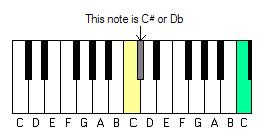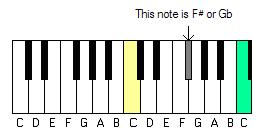In music theory, the term “accidentals” is used to describe some notes which have been slightly altered. Accidentals are the symbols which are placed before the note on the stave – they can be “sharps”, “flats” or “naturals”.
In this unit we’ll have a look at what accidentals are exactly, and how they are used in music theory.
The Octave
To begin, let’s look at a piano keyboard again.

The yellow note is middle C, and the green note is the next C above it. How many different notes are there between these two Cs?
If we count all the black and white notes, we’ll find there are 12 different notes. (Don’t count the C twice!) This span of notes is called an “octave”.
This isn’t only true for the piano – every instrument uses the same series of notes.
Sharps and Flats
So, we have 12 different notes, but we only use 7 letters of the alphabet. We use the words “sharp” (=higher) and “flat” (=lower) with a letter name, to cover all those “in-between” notes. Sharps and flats are two kinds of “accidentals”.
We can use symbols for accidentals, instead of the words sharp and flat.
Sharp symbol

Flat symbol

Find the notes C and D on this keyboard:
They are both white notes (the C is yellow to help you find it!). In between them, you’ll see a black note.

We can say that this note is a bit higher than C, so it is “C sharp” (C#), or we can say it is a bit lower than D, so it is also “D flat” (Db).
Here’s another example.
Find the notes F and G. The black note in between F and G can be called F sharp (F#) or G flat (Gb).

Here are all the notes between the two Cs. Click on the Play button to hear what they sound like:
Naturals
The third type of accidental we are going to look at is called the “natural”.
We use the word “natural” (or the symbol) to say that a note is neither sharp nor flat.
Natural symbol

This is very useful, because sometimes when a note has already been altered by an accidental (flat or sharp), we need to put a natural sign in to tell the player that it isn’t flat or sharp any more.
Flats, sharps and naturals make up the main accidentals, and they are the only accidentals you need to know for grade one music theory.
Questions on Accidentals
In the Grade 1 music theory exam, you are sometimes asked to identify the higher or lower note of a pair. The notes will be in the same position on the staff, but have different accidentals next to them.
Remember that flats are low and sharps are high, while naturals are in the middle.
Which of these two notes is lower?

The first note is G natural, and the second note is G flat. Flats are lower, so the second note is lower.
Which of these two notes is lower?

The first note is G natural, and the second note is G sharp. Sharps are higher, so the first note is lower.
Bar lines and Accidentals
When an accidental has been written, all the other notes which are the same pitch, (or position on the staff), are also affected by the accidental, but only until a bar line is drawn.
Here’s an example:

1 is natural, because we haven’t put any accidentals.
2 is flattened by the flat symbol.
3 is also flattened by the symbol from number 2, because it’s in the same bar.
4 is natural, because the bar line cancels the effect of the flat.
5 is flattened by the accidental symbol.
6 is naturalised by the bar line.
Notes of the same letter name, but which are written at different positions on the staff, are not affected by each other’s accidentals.

Note 3 is a G natural. The flat on number 2 doesn’t affect it, because it’s not the same pitch – it’s an octave higher.
Accidentals Exercises
Point your mouse at the staff (tap on mobiles) to reveal the answers.
1. For each pair of notes, circle the one which is higher.






2. For each pair of notes, circle the one which is lower.






3. Circle every A flat in this extract.

4. Circle every C sharp in this extract.
